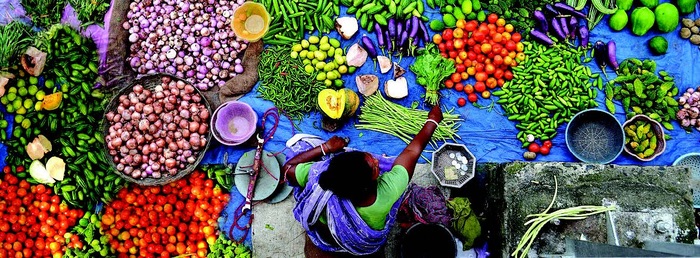
Podcast: Play in new window | Download (Duration: 23:46 — 21.9MB)
Subscribe: Google Podcasts | Spotify | Android | RSS | More
 About two billion people around the world do not get enough micronutrients in their diet. This lack of vitamins and minerals — often called hidden hunger — has severe and lasting effects on individuals and their societies. One very popular approach to tackling hidden hunger is known as biofortification, engineering or selecting varieties of staple crops so that they produce higher levels of one micronutrient or another. On the surface, this makes perfect sense. Hidden hunger is strongly correlated with the amount of energy people get from staples, so putting more micronutrients in those staples ought to be a good thing, except that there’s little evidence that it works and yields of biofortified staples are generally lower than those of unfortified varieties. That’s a waste of land that could be used to grow the fruits and vegetables that contribute to a more diverse diet, which offers a far better approach to micronutrient deficiencies.
About two billion people around the world do not get enough micronutrients in their diet. This lack of vitamins and minerals — often called hidden hunger — has severe and lasting effects on individuals and their societies. One very popular approach to tackling hidden hunger is known as biofortification, engineering or selecting varieties of staple crops so that they produce higher levels of one micronutrient or another. On the surface, this makes perfect sense. Hidden hunger is strongly correlated with the amount of energy people get from staples, so putting more micronutrients in those staples ought to be a good thing, except that there’s little evidence that it works and yields of biofortified staples are generally lower than those of unfortified varieties. That’s a waste of land that could be used to grow the fruits and vegetables that contribute to a more diverse diet, which offers a far better approach to micronutrient deficiencies.
All this and more is brought out in a recent paper in the journal Global Food Security. I interviewed one of the authors.
Notes
- What is Wrong with Biofortification, by Maarten van Ginkel and Jeremy Cherfas, can be read in Global Food Security.
- A previous episode examined orange-fleshed sweet potato to feed hidden hunger, and there was evidence that OFSP can increase vitamin A status in children. I didn’t ask about yield.
- Here is the transcript.
- Banner photograph from Western Bengal, by Krishnasis Ghosh for The Alliance of Bioversity International and CIAT.

[…] webinar on biofortification yesterday. But fear not, the recording will be up soon, and of course Jeremy interviewed one of the authors of the Global Food Security paper behind the whole thing last year. Yes, he […]
In a podcast unpacking biofortification, Jeremy Cherfas explores how science has not delivered on the promises, especially regarding yield. One of the interesting points raised is the idea of ‘hidden hunger’, this is where people get enough food, but not enough micronutrients.
This idea had me thinking about our digital diets, where we often get too much information, but not enough critical content. This can subsequently leave us with ‘hidden hunger’. Although we may spend time clicking and consuming social media, there is something missing.
One place I have found myself continually going to over the last few years has been The Minefield podcast featuring lecturer in politics and journalist, Waleed Aly, and, philosopher and theologian, Scott Stephens. Their weekly discussions diving into wicked problems always leave me thinking differently about the world around me. In part, this is for the way in which they never quite agree, but always find some sort of consensus. (For me, their dialogue represents what Angus Hervey describes as holding on tightly and letting go lightly.) I was therefore intrigued to read their Quarterly Essay Uncivil Wars: How Contempt Is Corroding Democracy
At its heart, Uncivil Wars argues that democracy cannot survive contempt. Democracy, Aly and Stephens explain, is about cultivating a common life even in the presence of serious disagreement, while contempt is about having no life in common at all. They suggest that, to make this argument requires a careful consideration of both contempt and democracy, but it also requires us to think about the conditions in which we are going about our democratic lives. So they divide their argument into three stages.
Aly and Stephens describe contempt as being personal, judgmental, comparative, performative, an enduring disposition, a way of acting and feeling towards others. Breaking this down further, they identify three particular types of contempt:
Patronising Contempt. This is ‘knowing without being known, speaking without being addressed.’ An example is Malcolm Turnball’s dismissal the Uluru Statement from the Heart where he showed contempt for indigenous people with the way in which he rejected it.Downward Contempt. This is contempt that focuses on hierarchical order. An example of this is slavery and the prioritising one group over another.Moral Contempt. This is contempt that is not necessarily pre-existing, but arises out of a situation. It is the staple of tabloid journalism. It is also epitomised in the Robodebt’s contempt towards those receiving government payments and cancel culture.
Aly and Stephens point out that these three types are not mutually exclusive. For example, the response to Yassmin Abdel-Magied a few years ago mixes cancel culture with a downward contempt of gender and religion. In the end, these three types are brought together by there deep dismissal of others with no place for forgiveness. Oddly, contempt is often self-fulfilling.
For Aly and Stephens, ‘air’ is more than the oxygen we breathe, it is the space that occupies the space, it is where democracy exists. They use a quote from Luce Irigaray to capture the way in which our public life is beholden to the air that we breathe.
Sadly, actions such as ‘likes’ and ‘retweets’ in the open air of Twitter serve as moral contagion and help build outgroup animosity. Social media acts as a contempt machine and helps push us all towards the tabloidisation of everything.
Aly and Stephens use a quote from Ralph Waldo Emerson discussing the way in which Fugitive Slave Law in 1850 made everyone culpable for slavery to capture the situation.
Rather than tending to the air, media platforms suck everyone into a game where virality is the goal. Every speech act is reduced to a positive or negative response, this leads to a situation where contempt occurs before moral considerations of the other. This leaves us incomprehensible, unknown and unknowable to others.
Although there are always limits, the problem is that in the modern world this has become the first questions we ask. Little room is left for complexity and consensus. For Aly and Stephens, our focus should be on ‘thick democracy’, the reciprocal act of hope, interdependence and attention.
Borrowing from Simone Weil, they talk about the importance of being attentive to the best of arguments of the others view, rather than a caricature. Weil talks about the symbolic language of lovers and the way this cultivates the relationship. With this, we need to think of democracy as a marriage that is continually cultivated.
With the movement away from platforms like Twitter and Facebook, it can be a useful time to consider what such spaces serve and what a constructive alternative maybe to borrow from Doug Belshaw. What might it mean to form what Eli Pariser has described as ‘online parks‘:
All in all, Uncivil Wars is a thought provoking book, which demands attention and consideration.
If you enjoy what you read here, feel free to sign up for my monthly newsletter to catch up on all things learning, edtech and storytelling.
REVIEW: Uncivil Wars – How Contempt Is Corroding Democracy by Aaron Davis is licensed under a Creative Commons Attribution-ShareAlike 4.0 International License.
Wait, what? Against biofortification? What can possibly be the case against breeding staple crops to have higher concentrations of micronutrients? How can you argue against making wheat or beans more nutritious?
Well, in his latest Eat This Podcast episode, Jeremy interviews one of the authors of a paper which argues just that. And that author is…Jeremy:
Maarten van Ginkel and Jeremy go on to say that a much better way to tackle micronutrient deficiencies — hidden hunger — is more diverse diets.
In fact, I think even uber-biofortificators such as HarvestPlus would probably concede that point, judging by an article they have just released marking their twentieth anniversary. Though that may not always have been the case.
Be that as it may, I think each of Maarten and Jeremy’s drawbacks of biofortification can be disputed, or indeed rectified, as they in fact concede, to be fair. For example, does a yield penalty actually matter everywhere? And has the release of a biofortified variety in an area actually led to a decrease in genetic diversity there? And if it has, could that not be addressed simply by more, and more diverse, biofortified varieties? And yes, the evidence that release of a biofortified variety translates into positive nutritional outcomes is limited and patchy — but not non-existent.
Anyway, the central fact remains that we still don’t know whether a more holistic approach to hidden hunger through diet diversification would have been more cost-effective and sustainable than the at least $500 million or so that Maarten and Jeremy have gone into biofortification.